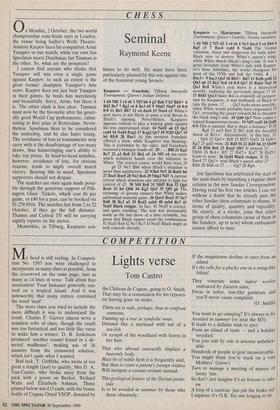CHESS
Seminal
Raymond Keene
On Monday, 2 October, the two world championship semi-finals start in London, the venue being Sadler's Wells Theatre. Anatoly Karpov faces his compatriot Artur Yusupov in one match, while our own Jon Speelman meets Dutchman Jan Timman in the other. So, what are the prospects?
I cannot find anyone who thinks that Yusupov will win even a single game against Karpov, to such an extent is the great former champion Yusupov's bete noire. Karpov does not just beat Yusupov in their games, he beats him mercilessly and beautifully. Sorry, Artur, but there it is. The other clash is less clear. Timman must now be the favourite after his gener- ally good World Cup performance, culmi- nating in first prize at Rotterdam. Never- theless, Speelman likes to be considered the underdog, and he also hates losing. The avoidance of loss in tournaments may carry with it the disadvantage of too many draws, thus hamstringing one's ability to take top prizes. In head-to-head matches, however, avoidance of loss, for obvious reasons, tends to imply overall match victory. Bearing this in mind, Speelman supporters should not despair.
The matches are once again made possi- ble through the generous support of Pilk- ington Glass. Tickets, which cost £6 per game, or £40 for a pass, can be booked via 01-278 8916. The matches last from 2 to 22 October, if they go the full distance. Thames and Central TV will be carrying nightly reports on the moves.
Meanwhile, in Tilburg, Kasparov con- tinues to do well. He must have been particularly pleased by this win against one of the foremost young Soviets.
Kasparov — Ivanchuk: Tilburg Interpolis Tournament; Queen's Indian Defence.
1 d4 Nf6 2 c4 e6 3 Nf3 b6 4 g3 Ba6 5 b3 Bb4+ 6 Bd2 Bel 7 Bg2 c6 8 Bc3 d5 9 Nbd2 Nbd7 10 0-0 0-0 11 Re1 Bb7 12 e4 dxe4 13 Nxe4 c5 White's next move is not likely to pose a real threat to Black's opening. Nevertheless, Kasparov appears content to play a waiting game against his less experienced rival. 14 Ned2 a6 15 Qe2 cxd4 16 Nxd4 Bxg2 17 Kxg2 Qc7 18 N2f3 Qb7 19 b4 RfcS 20 Racl At this moment Ivanchuk offered a draw, while Kasparov was thinking. This is forbidden by the rules, and Ivanchuck received a brusque brush-off. 20 . . . BIB 21 Kgl Rc7 22 a3 Re8 23 Bb2 e5 24 Nf5 e4 An error which definitely hands over the initiative to White. The correct course would have been, 24 . . . g6 25 Ne3 Bh6 when Black's situation is more than satisfactory. 25 N3h4 Ne5 26 Redl h6 27 BxeS RxeS 28 Ne3 Re6 29 Nhg2 Nd7 A curious retreat which abandons any attempt to fight for control of d5. 30 Nf4 Re8 31 NfdS Rc6 32 Qg4 Rce6 33 h4 Qb8 34 Kg2 Qe5 35 Qf5 g6 The exchange of queens ensures that White makes substantial material gains. 36 QxeS RxeS 37 Nc7 Rd8 38 Rc2 a5 39 Rcd2 axb4 40 axb4 Re7 41 Ncd5 Black resigns. In fact, 41 Ned5 is correct, and quite crushing. The text was presumably made as the last move of a time scramble, but given that Black cannot avoid the continuation 41 Ncd5 Re6 42 Nc7 Re7 43 Ned5 Black might as well concede directly. Kasparov — Hjartarson: Tilburg Interpolis Tournament; Queen's Gambit, Vienna variation.
1 d4 Nf6 2 Nf3 d5 3 c4 e6 4 Nc3 dxc4 e4 Bb4 6 Bg5 c5 7 Bxc4 cxd4 8 Nxd4 The Vienna variation, sharp and dangerous for both sides. Black tries to destroy White's queen's wing, while White shreds Black's king's side. It was a great favourite from White's side with Kaspar- ov's hero Alekhine, the world champion for most of the 1930s and half the 1940s. 8 . • • Bxc3+ 9 bxc3 Qa5 10 Bb5+ Bd7 11 Bxf6 gxf6 12 Qb3 a6 13 Be2 Nc6 14 0-0 Qc7 15 Ram Na5 16 Qa3 Re8 White's next move is a theoretical novelty, replacing the previously played 17 c4. 17 Rfdl Qxc3 Since this is evidently all prepara- tion by Kasparov, it was foolhardy of Black to take the pawn. 17 . . . Qc5 looks more sensible, when White would probably have responded 18 Qcl, rerouting the queen towards h6 to threaten the black king's side. 18 Qd6 Qc7 Now comes a typical Kasparovian stroke. 19 Nf5! exf5 20 Qxf6 0-0 This is suicidal. But is there a defence? If 20 . . . Rg8 21 exf5 Bc6 22 Bfl with the dreadful threat of Rel+. Alternatively, in this line, 21 . . . Qc6 22 Qe5+ Kf8 23 Bf3!! Qxf3 24 Qd6+ Kg7 25 gxf3 wins. 21 Rd3 f4 22 Rd5 h6 23 Qxh6 f5 24 Rb6 Bc6 25 RxaS Qh7 If instead 25 . • • Qxb6 26 Bc4+ Rf7 27 Bxf7+ Kxf7 28 Rx15+ leads to mate. 26 Qxf4 Black resigns. If 26 . • • Bxe4 27 Qg5+ wins Black's queen after 27 . • • Kh8 28 Rh6 or 27 . . . Qg7 28 Rg6.
Jon Speelman has celebrated the start of the semi-finals by launching a regular chess column in the new Sunday Correspondent. Having read his first two articles I can say without a doubt that he already puts the other Sunday chess columnists to shame, in terms of quality, quantity and topicality. He clearly, at a stroke, joins that select group of chess columnists (none of them in the Sundays, up to now) whom enthusiasts cannot afford to miss.


























































 Previous page
Previous page